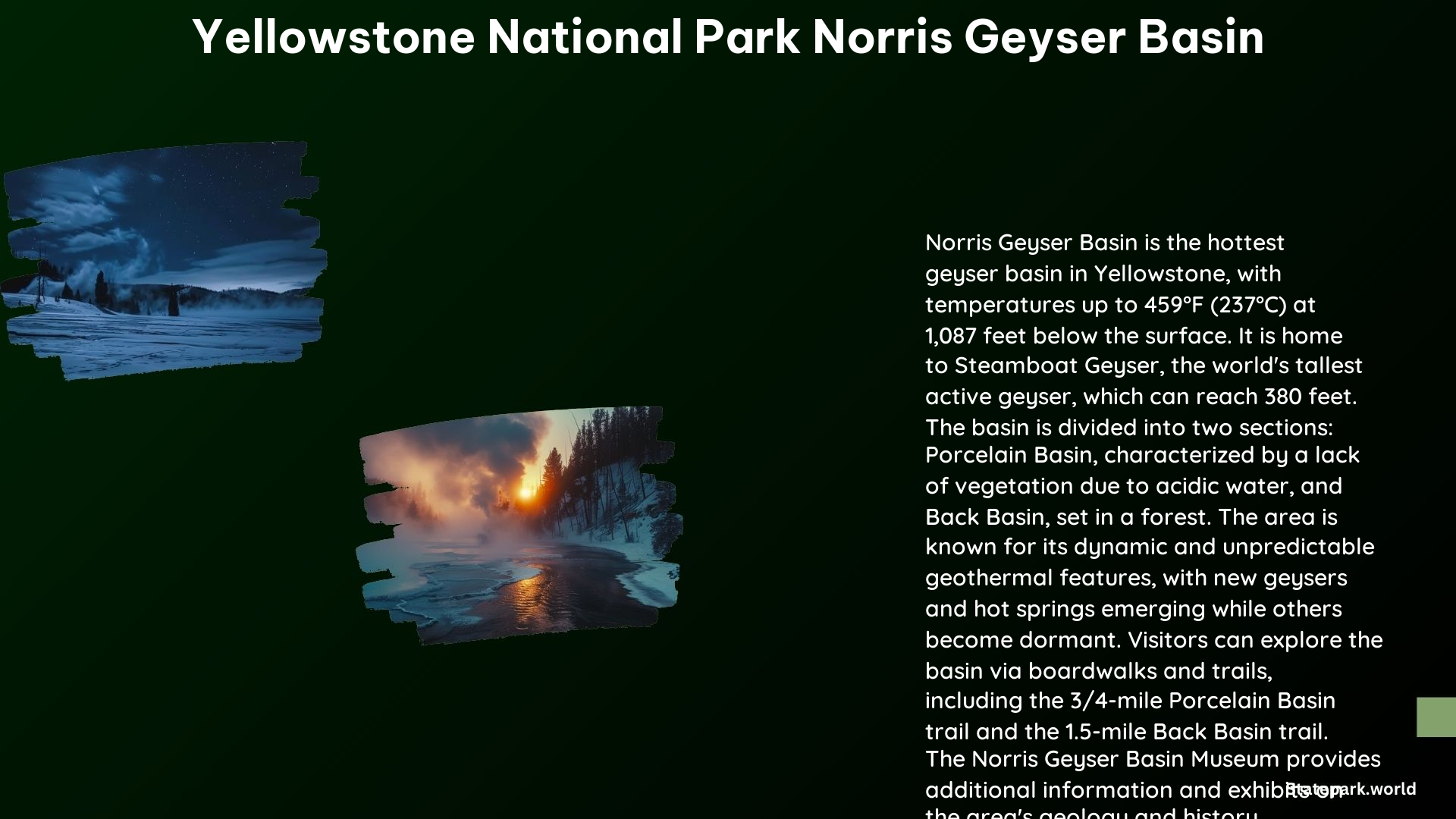Yellowstone National Park’s Norris Geyser Basin is a captivating and dynamic thermal area that showcases the raw power of the Earth’s geothermal activity. As the hottest and oldest geyser basin in the park, Norris offers visitors a unique opportunity to witness the ever-changing landscape of steaming hot springs, fumaroles, and the world’s tallest active geyser, Steamboat Geyser.
Overview of Norris Geyser Basin
Norris Geyser Basin is renowned for its exceptional thermal features, with temperatures often exceeding the boiling point of water (200°F/93°C) in many of its hot springs and fumaroles. This basin is also the oldest in Yellowstone, with evidence of thermal activity dating back at least 115,000 years.
Unique Features of Norris Geyser Basin

Steamboat Geyser
The crown jewel of Norris Geyser Basin is Steamboat Geyser, the tallest active geyser in the world. Capable of erupting to heights of 300-400 feet (91-122 meters), Steamboat’s unpredictable and powerful displays are a sight to behold.
Echinus Geyser
Another notable feature of Norris is Echinus Geyser, known for its frequent and reliable eruptions that can reach up to 40 feet (12 meters) in height.
Porcelain Basin
The Porcelain Basin is a unique area within Norris characterized by a lack of vegetation due to the hot, acidic water emitted from the numerous thermal features in the basin.
Back Basin
In contrast, the Back Basin is a forested area with geysers and hot springs scattered throughout, providing a more serene and natural setting for visitors.
Trails and Accessibility
The trails through Norris Geyser Basin are a combination of boardwalks, paved paths, and unpaved paths, allowing visitors to explore the area safely. There are two main loops: one through the Porcelain Basin and one through the Back Basin.
While the trails are generally accessible, visitors are advised to stay on the designated paths due to the dynamic and unpredictable nature of the thermal features in the basin.
Dynamic Nature of Norris Geyser Basin
Norris Geyser Basin is a constantly evolving landscape, with new hot springs and geysers appearing while others become dormant. Geologic events, such as earthquakes, can also alter the hydrothermal behavior, leading to changes in the features.
The basin also experiences sudden changes in thermal activity, known as “thermal disturbances,” which can last from a few days to over a week, further adding to the dynamic nature of this unique area.
Wildlife and Ecology
Norris Geyser Basin provides a warm respite for elk and bison during the winter months, and these majestic animals can often be spotted in the area. The basin is also home to a variety of insects associated with thermophiles, as well as colorful dragonflies.
Visitor Information
The parking lot at Norris Geyser Basin serves both the basin and the Norris Geyser Basin Museum, which is a historic building that provides park information and facilitates ranger programs. The museum was completed in 1930 and is a National Historic Landmark.
Visiting Norris Geyser Basin is free, and the trails and museum are open during park hours, with specific timings varying depending on the season and park conditions.
Conclusion
Yellowstone National Park’s Norris Geyser Basin is a truly remarkable and dynamic thermal area that showcases the incredible power of the Earth’s geothermal activity. From the towering Steamboat Geyser to the ever-changing landscape of hot springs and fumaroles, Norris offers visitors a unique and unforgettable experience in one of the most geologically active places on the planet.
References
- https://yellowstone.net/intro/norris/
- https://www.tripadvisor.com/Attraction_Review-g60999-d145231-Reviews-Norris_Geyser_Basin-Yellowstone_National_Park_Wyoming.html
- https://www.nps.gov/thingstodo/yell-norris-geyser-basin-trails.htm
- https://www.nps.gov/yell/planyourvisit/norrisplan.htm
- https://www.nps.gov/yell/planyourvisit/norris-geyser-basin-museum.htm
